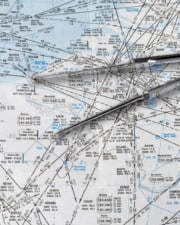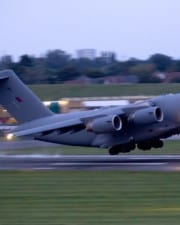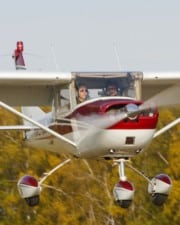The speed an aircraft flies is one of those things that seems like it should be simple, and yet it isn’t easy. In a car, your speedometer simply tells you how fast you are traveling between Point A and Point B. But in a plane, many variables must be considered before you can figure that out.
Table of Contents
What Does KIAS Stand For?
KIAS means “knots of indicated airspeed.” Knots are a unit of speed, just like miles per hour (MPH) or kilometer per hour (KPH), and indicated airspeed is simply the number shown on the airspeed indicator. KIAS is used for most tasks in the cockpit since it is easily referenced and shown clearly on the instrument. It’s the flying equivalent of reading your car’s speedometer.

What is KIAS?
Pilots need to specify what type of airspeed is being referred to because there are so many different kinds. Indicated airspeed is easy to read on the instrument, but it’s also subject to many inaccuracies. To properly plan their flight and calculate their ground speed (the actual speed between Point A and Point B), pilots must correct the indicated airspeed for many factors.
What is a Knot?
A knot is a nautical mile per hour. Distances are measured in aviation using nautical miles (NM), which are equal to the distance between one minute of latitude. The unit is standard for navigational purposes and used the world over, whether traveling by air or sea. It is the standard measurement on all charts that use latitude and longitude.
In other words, one NM is equal to 1.15 statute miles or 1.85 kilometers.
See our aviation unit conversion tool for converting units of measurement.
How Is Airspeed Measured?
Airspeed indicators are fundamentally simple instruments. They are connected to the aircraft’s pitot-static system, meaning that they use pressure readings outside the fuselage to get their information.

The most important part of the airspeed indicator is the pitot (pronounced PEE-tow) tube. This tube is mounted on the wing of the plane and points forward into the airflow. The faster the plane flies, the more air enters the pitot tube. This air pressure is transmitted to the airspeed indicator, where it presses against a flexible diaphragm.
The other side of the diaphragm is vented to the static port. The static port is an opening on the side of the aircraft, which is open to the atmospheric pressure outside.
When more air goes into the pitot tube, it presses on the airspeed indicator’s diaphragm, which moves the needle on the indicator up. Since the diaphragm is connected to the non-moving air on the other side, the indicator shows the difference in pressure between the moving air and the static air.
The dial on the airspeed indicator is calibrated to some extent to show accurate speeds when in straight and level flight. They are usually shown in knots, but some older units were built with miles per hour on the dial.
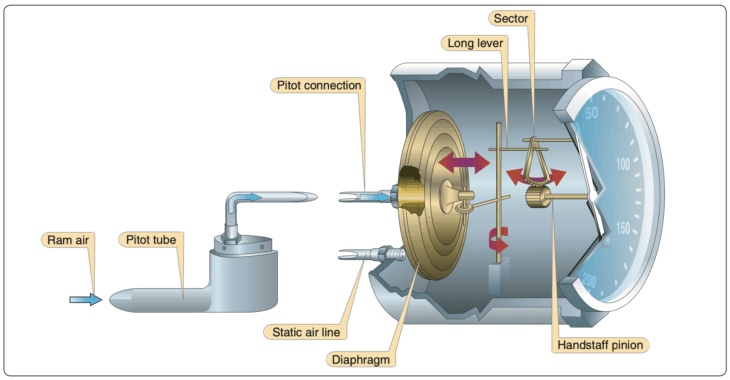
Types of Airspeed
Indicated Airspeed (IAS)
Indicated airspeed, or IAS, is read off of the instrument face in the cockpit.
Calibrated Airspeed (CAS)
Calibrated airspeed, or CAS, is indicated airspeed corrected for instrument errors. This is usually done with a correction table provided by the aircraft manufacturer. Errors typically occur at very high or very low angles of attack because the air does not enter the pitot tube directly.
Equivalent airspeed (EAS)
Equivalent airspeed (EAS), corrects calibrated airspeed for the compression of air at the pitot tube. This number isn’t used in small aircraft, but in fast airplanes, it’s a meaningful correction.
True airspeed (TAS)
True airspeed, or TAS, is the most accurate measure of airspeed.
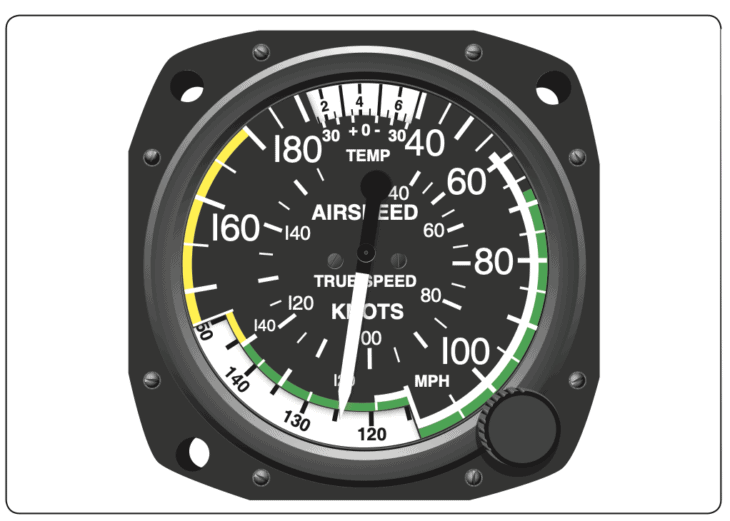
Airspeed indicators do not correct for altitude or atmospheric changes. As a result, indicated airspeed remains constant as the aircraft climbs higher and higher. But in truth, the plane is now flying much faster than it was a sea level. The reduced air pressure at high altitudes causes less friction on the aircraft and allows it to fly faster through the air.
To calculate true airspeed, pilots must correct their calibrated airspeed to their pressure altitude. This is usually done with a flight calculator. Most aircraft performance tables use TAS as the basis for how fast the aircraft can fly.
Ground Speed (GS)
The final type of speed that pilots use is ground speed (GS). Ground speed is true airspeed corrected for headwinds or tailwinds. Calculating ground speed before flying to another airport is a vital part of flight planning. GS is the only way to tell you how long it will take to get to your destination, and therefore how much fuel you will burn.
References ▾
Related Posts

